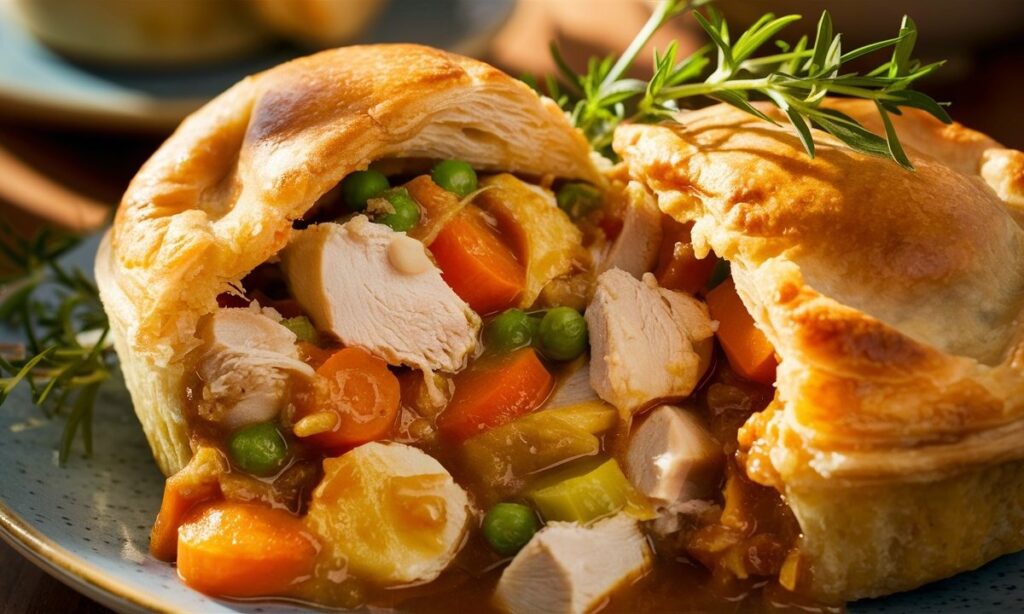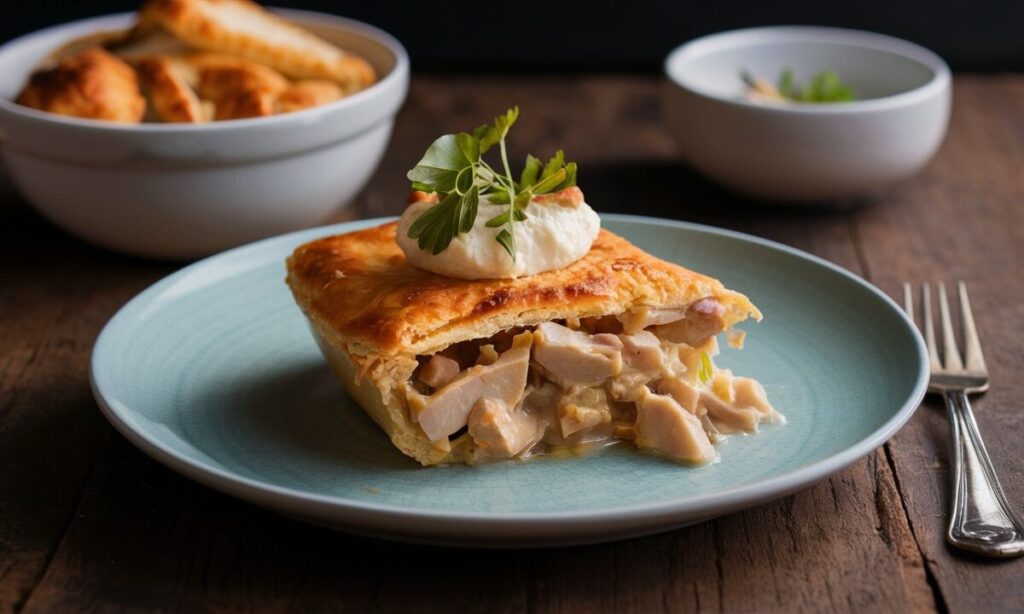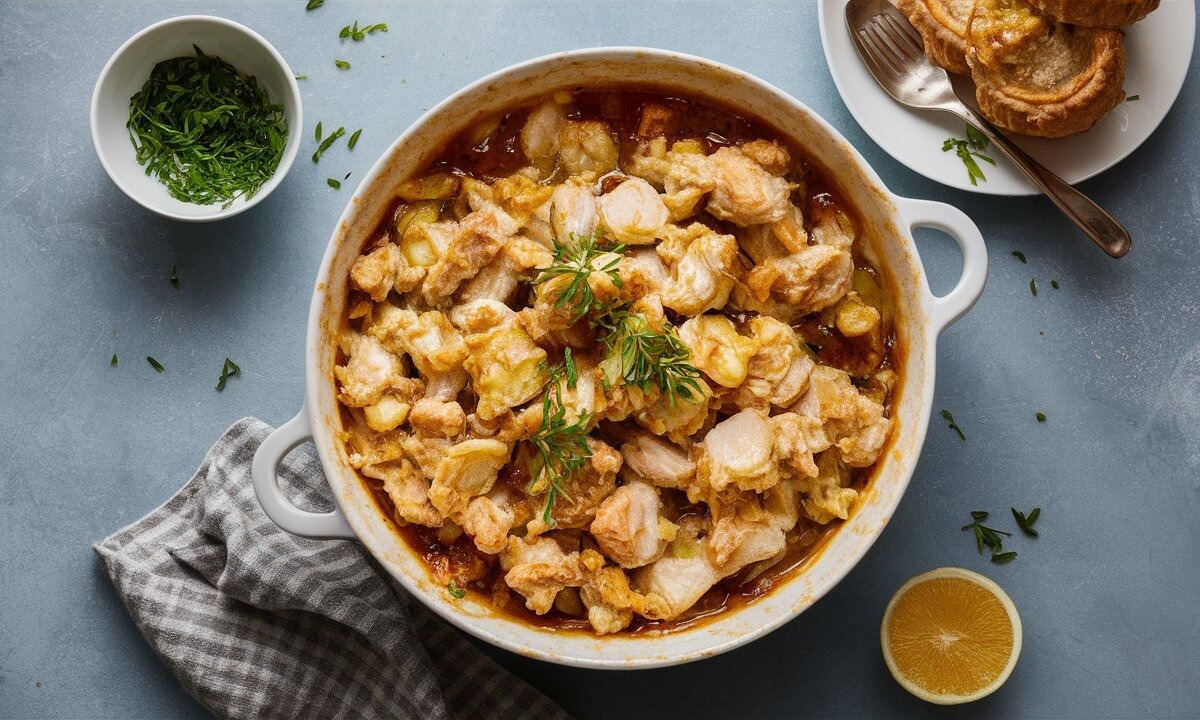Chicken pot pie is the ultimate comfort food, loved for its flaky crust, creamy filling, and hearty combination of chicken and vegetables. What exactly constitutes the filling? In this in-depth guide, we’ll explore the key ingredients that make up chicken pot pie filling, discuss various ways to prepare it, and provide expert tips to ensure your pot pie turns out perfectly every time.
Introduction: The Role of the Filling in Chicken Pot Pie
The filling is the heart and soul of a chicken pot pie. It’s what gives this classic dish its comforting, rich flavor and satisfying texture. While the crust often gets a lot of attention, it’s the filling that truly defines the dish. A well-made filling is creamy, savory, and packed with tender chicken, flavorful vegetables, and a luscious sauce that brings everything together.
In this post, we’ll deconstruct the components of chicken pot pie filling, explore the essential techniques for crafting the ideal filling, and explore potential variations to personalize this dish. Whether you’re a seasoned cook or just starting out, understanding the basics of this filling will set you up for success in the kitchen.
Chicken Pot Pie Filling: Essential Ingredients
While there are many variations of chicken pot pie, the classic filling typically contains a few key ingredients that work together to create its signature flavor and texture. Let’s explore these core components in detail.
1. Chicken: The Star Protein
Of course, the chicken is the main ingredient in the chicken pot pie filling. Typically, recipes use boneless, skinless chicken breasts or thighs, but some incorporate both to enhance flavor and texture. Cooking the chicken before adding it to the filling typically involves roasting, poaching, or even sautéing it. For an extra layer of flavor, many cooks prefer using leftover rotisserie chicken.
Why It’s Important: The chicken provides protein and substance to the dish, as well as absorbing the flavors from the sauce and vegetables. For the best results, use high-quality, fresh chicken, and avoid overcooking it to maintain tenderness.
2. Vegetables: Adding Flavor and Nutrition
Classic chicken pot pie filling includes a mixture of vegetables that add both flavor and texture. The most commonly used vegetables are:
- Carrots: These bring a natural sweetness and bright color to the filling.
- Peas: Frozen peas are a staple in chicken pot pie. They add pops of sweetness and a tender texture.
- Celery adds a subtle, savory flavor and a bit of crunch.
- Onion: Diced onion is essential for creating the filling’s base flavor. It adds a touch of sweetness and depth when sautéed.
Some variations also include corn, green beans, mushrooms, or potatoes, depending on personal preferences and regional variations.
Why It’s Important: Vegetables not only provide nutritional benefits but also contribute to the overall flavor and balance of the dish. They enhance the filling by adding color, texture, and interest.
3. The sauce is the creamy binding agent.
The sauce is arguably the most important component of chicken pot pie filling, as it binds all the ingredients together and gives the dish its creamy, comforting texture. Typically, we make the sauce using a combination of butter, flour, chicken broth, and either milk or cream. This mixture forms a roux-based sauce that thickens as it cooks, creating the luscious texture that chicken pot pie is known for.
Key Ingredients for the Sauce:
- Butter is the base fat used to make roux.
- Flour: The thickening agent that combines with butter to create the roux.
- Chicken broth enhances the savory flavor and richness of the sauce.
- Milk or cream provides the creamy texture that makes the sauce luxurious and comforting.
Typically, we add seasonings like salt, pepper, thyme, and parsley to enhance the flavor of the sauce.
Why It’s Important: The sauce is the glue that holds everything together, delivering moisture and richness to every bite. Getting the sauce right is crucial for achieving the perfect chicken pot pie filling.
4. Herbs and Seasonings: Enhancing the Flavor
Herbs and seasonings play a vital role in balancing and enhancing the flavors of the filling. The following herbs are commonly used in chicken pot pie:
- Thyme: A classic herb that adds earthy, slightly minty notes.
- Parsley brightens the flavor and adds a fresh finish.
- Bay leaf is frequently simmered in the sauce to impart a subtle, aromatic depth.
Seasonings like salt, pepper, and garlic powder are also essential for bringing out the flavors of the ingredients.
Why It’s Important: Proper seasoning is key to a delicious filling. Herbs and spices add complexity and depth, transforming a simple combination of ingredients into something truly flavorful.

How to Make Chicken Pot Pie Filling: Step-by-Step Instructions
Now that you know the essential components of chicken pot pie filling, let’s dive into the process of making it from scratch. Follow these steps to create a filling that’s creamy, savory, and packed with flavor.
1. Cook the chicken.
Start by cooking your chicken. You can roast, poach, or sauté the chicken breasts or thighs until fully cooked. Once done, let the chicken cool slightly before cutting it into bite-sized pieces. You can also use pre-cooked rotisserie chicken to save time.
2. Prepare the vegetables.
While the chicken is cooking, dice the carrots, celery, and onion. If you’re using fresh vegetables like green beans or corn, prepare those as well. Sauté the diced onion in butter over medium heat until it becomes soft and translucent. Cook the carrots and celery until they start to soften.
3. Make the sauce (roux-based)
In the same pan used to sauté the vegetables, melt additional butter. Sprinkle flour over the butter and whisk to form a roux. Cook the roux for 1-2 minutes, stirring constantly, to remove the raw flour taste. Gradually pour in the chicken broth while whisking, followed by the milk or cream. Continue to cook the sauce, whisking frequently, until it thickens to a smooth, creamy consistency.
4. Add the vegetables and chicken.
Once the sauce has thickened, stir in the cooked chicken, peas, and any other vegetables you’re using. Season with salt, pepper, thyme, and parsley. Allow the mixture to simmer for a few minutes so that all the flavors meld together.
5. Final adjustments and assembly
Taste the filling, and adjust the seasoning as needed. The filling should be thick but not overly dry—if it’s too thick, you can thin it out with a little more broth. You can now pour the filling into a pie crust, bake it, or store it for later use.
Variations on Chicken Pot Pie Filling
While the classic filling is always a winner, there are countless ways to put your own spin on it. Here are some popular variations:

1. Filling a vegetarian pot pie
For a meat-free version, replace the chicken with extra vegetables like mushrooms, potatoes, and zucchini. You can also add chickpeas or lentils for added protein and texture. Instead of using chicken broth, you can make the sauce using vegetable broth.
2. Dairy-Free and Gluten-Free Filling
To make a dairy-free filling, substitute the butter with plant-based margarine and use almond milk, oat milk, or coconut milk in place of cream. Use gluten-free flour to make the roux, or opt for cornstarch as a thickener for a gluten-free version.
3. Creamy garlic and herb filling
For a more intense flavor, incorporate roasted garlic and extra herbs like rosemary and sage into the filling. This variation offers a robust, aromatic twist on the traditional recipe.
4. Spicy Chicken Pot Pie Filling
Incorporate red pepper flakes, paprika, or a dash of hot sauce into the filling to add a bit of heat. This version is perfect for those who enjoy a kick of spice with their comfort food.
Nutritional Insights: What’s in Chicken Pot Pie Filling?
While chicken pot pie filling is undeniably rich and indulgent, it does offer a range of nutrients, depending on the ingredients used. Here’s a breakdown of the nutritional aspects:
Protein from Chicken
Chicken is a lean source of protein, which is essential for muscle growth and repair. A serving of chicken pot pie filling provides a significant portion of your daily protein needs.
Vegetables provide vitamins and fiber.
The carrots, peas, and other vegetables in the filling contribute essential vitamins like vitamin A (from carrots) and vitamin C (from peas), along with dietary fiber that supports digestive health.
Fat from Butter and Cream
The butter and cream in the filling add a rich flavor and creamy texture, but they also increase the fat content. If you’re watching your fat intake, you can reduce the amount of butter or use a lower-fat alternative like milk instead of cream.
Carbohydrates from the Roux
The roux is made with flour, which adds carbohydrates to the dish. For those following low-carb diets, you can reduce the amount of flour or use a different thickening agent, such as almond flour or xanthan gum.
Expert Tips for Perfect Chicken Pot Pie Filling
Even with the right ingredients and technique, there are a few tricks that can help you achieve the perfect filling every time.
1. Don’t overcook the chicken.
To keep the chicken tender and juicy, avoid overcooking it. If using pre-cooked chicken, add it to the filling at the end to simply warm it through rather than cooking it further.
2. Use fresh herbs for enhanced flavor.
Fresh herbs like thyme and parsley add a burst of flavor and freshness that dried herbs can’t match. To preserve their vibrant taste, add them near the end of cooking.
3. Adjust the consistency of the sauce.
The ideal chicken pot pie filling should be creamy and thick, but not overly heavy. If the sauce is too thick, thin it out with a little extra broth or milk. If it’s too thin, let it simmer a bit longer to reduce and thicken.
4. Taste as You Go
Seasoning is key to a flavorful filling, so taste the mixture frequently as you cook. Adjust the salt, pepper, and herbs until the filling is perfectly balanced.
5. Let the filling cool before assembling.
If you’re making a traditional pot pie with a top crust, allow the filling to cool slightly before assembling. This prevents the crust from becoming soggy and ensures even baking.
Frequently Asked Questions (FAQs)
1. Can I Make Chicken Pot Pie Filling Ahead of Time?
Making the filling ahead of time lets you store it in the fridge for 3 days. When you’re ready to bake, simply reheat the filling, then assemble your pot pie and bake as usual.
2. Is it possible to freeze the chicken pot pie filling?
Absolutely. You can freeze the filling for up to 3 months. First, thaw it overnight in an airtight container or freezer bag in the fridge. Reheat gently on the stovetop before assembling your pie.
3. What’s the Best Way to Thicken Chicken Pot Pie Filling?
If your filling is too thin, you can thicken it by adding a flour and broth slurry or by simmering it longer to reduce the liquid. Incorporate the slurry into the filling and cook until thickened.
4. Can I Use Rotisserie Chicken?
Yes, rotisserie chicken is a fantastic time-saver and adds a lot of flavor to the filling. Simply shred the cooked chicken and add it to the sauce, along with the vegetables.
5. What is the difference between Chicken Pot Pie and Chicken and Dumplings?
Chicken pot pie bakes with a pastry crust, while chicken and dumplings cook with soft, doughy dumplings simmered in the filling. Both dishes are comfort foods featuring chicken and a creamy filling.
The history and evolution of chicken pot pie
Chicken pot pie has a rich history that dates back to medieval times, when savory pies were a practical way to preserve and transport food. Early pies often contained meat, game, and vegetables encased in a thick, sturdy crust. The version we know today with its creamy filling and flaky pastry evolved over centuries and became popular in both British and American cuisines.
In the United States, chicken pot pie has become a symbol of comfort and homecooked goodness. It’s a dish often associated with family gatherings and nostalgic memories. Over time, many regional and cultural variations have emerged, reflecting the diversity and creativity of home cooks.
Conclusion: Mastering Chicken Pot Pie Filling
Understanding what goes into chicken pot pie filling and how to prepare it is the key to creating a delicious, comforting dish. From choosing the right ingredients to perfecting the technique, this guide provides everything you need to know to make a filling that’s creamy, flavorful, and satisfying.
Whether you stick to the classic recipe or experiment with your own variations, mastering the filling will allow you to create a dish that’s both nostalgic and timeless. So, gather your ingredients, follow the steps, and enjoy the process of making a hearty chicken pot pie that’s sure to become a family favorite.
